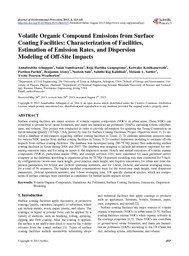| dc.contributor.author | Athappan, Annabrabha | |
| dc.contributor.author | Sumitsawan, Sulak | |
| dc.contributor.author | Gangupomu, Roja Haritha | |
| dc.contributor.author | Kositkanawuth, Ketwalee | |
| dc.contributor.author | Parikh, Parthen | |
| dc.contributor.author | Afotey, Benjamin Nmai | |
| dc.contributor.author | Sule, Neelesh | |
| dc.contributor.author | Kalidindi, Sahithi Raj | |
| dc.contributor.author | Sattler, Melanie L. | |
| dc.contributor.author | Weatherton, Yvette Pearson | |
| dc.date.accessioned | 2016-12-19T22:03:57Z | |
| dc.date.available | 2016-12-19T22:03:57Z | |
| dc.date.issued | 2013-08 | |
| dc.identifier.citation | Published in the Journal of Environmental Protection 4: 123-141, 2013 | en_US |
| dc.identifier.issn | 2152-2219 | |
| dc.identifier.uri | http://hdl.handle.net/10106/26312 | |
| dc.description.abstract | Surface coating facilities are major sources of volatile organic compounds (VOCs) in urban areas. These VOCs can
contribute to ground-level ozone formation, and many are hazardous air pollutants (HAPs), including xylene, ethylbenzene, and toluene. This project was conducted in order to provide information for updating the Texas Commission on
Environmental Quality (TCEQ), USA, permit by rule for Surface Coating Facilities. Project objectives were: 1) To develop a database of information regarding surface coating facilities in Texas; 2) To estimate maximum emission rates
for various VOC species from surface coating facilities in Texas; 3) To conduct dispersion modeling to estimate off-site
impacts from surface coating facilities. The database was developed using 286 TCEQ permit files authorizing surface
coating facilities in Texas during 2006 and 2007. The database was designed to include information important for estimating emission rates, and for using as inputs to the dispersion model. Hourly and annual emissions of volatile organic
compounds (VOCs), particulate matter (PM), and exempt solvents (ES) were calculated for each permitted entity/
company in the database, according to equations given by TCEQ. Dispersion modeling was then conducted for 3 facility configurations (worst-case stack height, good practice stack height, and fugitive emissions), for urban and rural dispersion parameters, for 8-hour and 24-hour operating scenarios, and for 1-hour, 24-hour, and annual averaging times,
for a total of 36 scenarios. The highest modeled concentrations were for the worst-case stack height, rural dispersion
parameters, 24-hour operation scenario, and 1-hour averaging time. 108 specific chemical species, which are components of surface coatings, were identified as candidates for further health impacts review. | |
| dc.language.iso | en | en_US |
| dc.publisher | Scientific Research Publishing | en_US |
| dc.rights | Attribution 3.0 United States | * |
| dc.rights.uri | http://creativecommons.org/licenses/by/3.0/us/ | * |
| dc.subject | Volatile Organic Compounds (VOCs) -- Urban areas | en_US |
| dc.subject | Volatile Organic Compounds (VOCs) -- Texas | en_US |
| dc.subject | Surface coating facilities -- Texas | en_US |
| dc.subject | Texas Commission on Environmental Quality (TCEQ) | en_US |
| dc.subject | Hazardous Air Pollutants -- Emissions | en_US |
| dc.subject | Dispersion Modeling | en_US |
| dc.title | Volatile Organic Compound Emissions from Surface Coating Facilities: Characterization of Facilities, Estimation of Emission Rates, and Dispersion Modeling of Off-Site Impacts | en_US |
| dc.type | Article | en_US |
| dc.publisher.department | Department of Civil Engineering, The University of Texas at Arlington | en_US |
| dc.identifier.externalLinkDescription | The original publication is available at Article DOI | en_US |
| dc.identifier.doi | http://dx.doi.org/10.4236/jep.2013.48A101 | |



